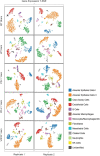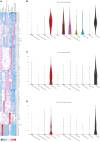Application of single cell multiomics points to changes in chromatin accessibility near calcitonin receptor like receptor and a possible role for adrenomedullin in the post-shock lung
- PMID: 37113606
- PMCID: PMC10126233
- DOI: 10.3389/fmed.2023.1003121
Application of single cell multiomics points to changes in chromatin accessibility near calcitonin receptor like receptor and a possible role for adrenomedullin in the post-shock lung
Abstract
Introduction: Acute lung injury (ALI)/acute respiratory distress syndrome (ARDS) is a commonly occurring sequelae of traumatic injury resulting from indirect insults like hypovolemic shock and/or extrapulmonary sepsis. The high lethality rate associated with these pathologies outlines the importance of clarifying the "priming" effects seen in the post-shock lung microenvironment, which are understood to bring about a dysregulated or overt immune response when triggered by a secondary systemic infectious/septic challenge culminating in ALI. In this pilot project, we test the hypothesis that application of a single cell multiomics approach can elucidate novel phenotype specific pathways potentially contributing to shock-induced ALI/ARDS.
Methods: Hypovolemic shock was induced in C57BL/6 (wild-type), PD-1, PD-L1, or VISTA gene deficient male mice, 8-12 weeks old. Wild-type sham surgeries function as negative controls. A total of 24-h post-shock rodents were sacrificed, their lungs harvested and sectioned, with pools prepared from 2 mice per background, and flash frozen on liquid nitrogen. N = 2 biological replicates (representing 4 mice total) were achieved for all treatment groups across genetic backgrounds. Samples were received by the Boas Center for Genomics and Human Genetics, where single cell multiomics libraries were prepared for RNA/ATAC sequencing. The analysis pipeline Cell Ranger ARC was implemented to attain feature linkage assessments across genes of interest.
Results: Sham (pre-shock) results suggest high chromatin accessibility around calcitonin receptor like receptor (CALCRL) across cellular phenotypes with 17 and 18 feature links, exhibiting positive correlation with gene expression between biological replicates. Similarity between both sample chromatin profiles/linkage arcs is evident. Post-shock wild-type accessibility is starkly reduced across replicates where the number of feature links drops to 1 and 3, again presenting similar replicate profiles. Samples from shocked gene deficient backgrounds displayed high accessibility and similar profiles to the pre-shock lung microenvironment.
Conclusion: High pre-shock availability of DNA segments and their positive correlation with CALCRL gene expression suggests an apparent regulatory capacity on transcription. Post-shock gene deficient chromatin profiles presented similar results to that of pre-shock wild-type samples, suggesting an influence on CALCRL accessibility. Key changes illustrated in the pre-ALI context of shock may allow for additional resolution of "priming" and "cellular pre-activation/pre-disposition" processes within the lung microenvironment.
Keywords: ALI; ARDS; multiomics; sepsis; shock; single cell; trauma.
Copyright © 2023 Armstead, Lee, Chen, Zhao, Chung, Fredericks, Monaghan and Ayala.
Conflict of interest statement
SM is founder of Alcini, LLC. The remaining authors declare that the research was conducted in the absence of any commercial or financial relationships that could be construed as a potential conflict of interest.
Figures







Similar articles
-
Genome-wide landscape of mRNAs, microRNAs, lncRNAs, and circRNAs in hemorrhagic shock-induced ALI/ARDS in rats.J Trauma Acute Care Surg. 2021 May 1;90(5):827-837. doi: 10.1097/TA.0000000000003119. J Trauma Acute Care Surg. 2021. PMID: 33605699
-
[Blockade of programmed death-ligand 1 attenuates indirect acute lung injury in mice through targeting endothelial cells but not epithelial cells].Zhonghua Wei Zhong Bing Ji Jiu Yi Xue. 2019 Jan;31(1):37-43. doi: 10.3760/cma.j.issn.2095-4352.2019.01.009. Zhonghua Wei Zhong Bing Ji Jiu Yi Xue. 2019. PMID: 30707867 Chinese.
-
Distinct and replicable genetic risk factors for acute respiratory distress syndrome of pulmonary or extrapulmonary origin.J Med Genet. 2012 Nov;49(11):671-80. doi: 10.1136/jmedgenet-2012-100972. Epub 2012 Oct 9. J Med Genet. 2012. PMID: 23048207 Free PMC article.
-
Delivery systems of therapeutic nucleic acids for the treatment of acute lung injury/acute respiratory distress syndrome.J Control Release. 2023 Aug;360:1-14. doi: 10.1016/j.jconrel.2023.06.018. Epub 2023 Jun 19. J Control Release. 2023. PMID: 37330013 Review.
-
Gut-Lung Crosstalk in Sepsis-Induced Acute Lung Injury.Front Microbiol. 2021 Dec 23;12:779620. doi: 10.3389/fmicb.2021.779620. eCollection 2021. Front Microbiol. 2021. PMID: 35003009 Free PMC article. Review.
Cited by
-
Mechanisms of immune suppression in sepsis/shock: one investigator's/lab group's experience (SLB 2024 legacy award presentation).J Leukoc Biol. 2025 Aug 5;117(8):qiaf108. doi: 10.1093/jleuko/qiaf108. J Leukoc Biol. 2025. PMID: 40702670
References
-
- Lomas JL, Chung CS, Grutkoski PS, LeBlanc BW, Lavigne L, Reichner J, et al. Differential effects of macrophage inflammatory chemokine-2 and keratinocyte-derived chemokine on hemorrhage-induced neutrophil priming for lung inflammation: assessment by adoptive cells transfer in mice. Shock. (2003) 19:358–65. 10.1097/00024382-200304000-00011 - DOI - PubMed
Grants and funding
LinkOut - more resources
Full Text Sources
Research Materials

